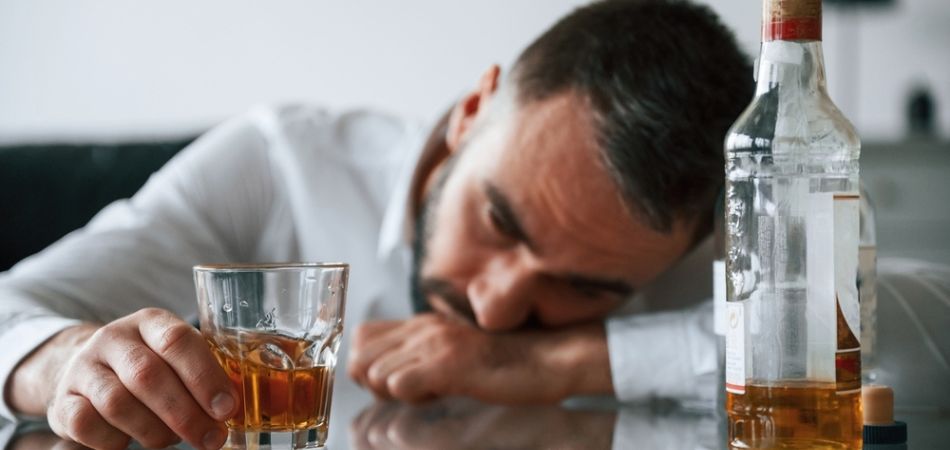Last Updated:
August 29th, 2025
If we paint a mental image of an alcoholic person, we may first picture someone slurring, slumped over, or completely passed out. These are some of the most overt signs that a person has drunk too much, yet they are only signs of the immediate impact of excessive drinking.
There are more covert signs to look for in an alcoholic, including effects on their face. These signs can suggest that alcohol addiction has deepened or reached a dangerous level.
We’re exploring some of the facial indicators in many people suffering from alcohol addiction. We’ll help you recognise them in a loved one and guide you to help reduce and potentially reverse some of the symptoms before they worsen.
Where is the line between alcohol use and alcoholism?
Alcohol has grown into a ubiquitous tool for socialising and bonding. Many of us use alcohol as a helper to unwind from a long day or week at work. It is commonplace at social gatherings, birthdays, or other causes for celebration. However, alcohol use may spiral into addiction or alcoholism faster and more silently than many people realise.
Alcoholism, which is clinically called alcohol use disorder (AUD), has very dangerous consequences as it worsens. It is defined as the inability to stop drinking despite the harmful consequences, including physical, mental or social effects.
There may be some warning signs that indicate the development of alcoholism, including, but not limited to:
- Drinking alone, or in secret
- Lying about the amount of alcohol consumed
- Continuing to drink, despite health detriments and relationship problems
- Needing alcohol to “function normally” when in a social setting
Many of the signs of deep alcoholism are psychological, yet there may be outward signals of its creeping control throughout the body, especially in the face.
Facial signs to spot in an alcoholic
Prolonged alcohol use is understood to have detrimental effects on every organ in the human body. However, we may only have the opportunity to see alcohol’s effects on a person’s face, which is also subject to visible changes.
These signs might not always confirm alcoholism, but if you see them alongside compulsive behavioural patterns towards alcohol, you might be witnessing a deepening issue. These signs include:
What causes the effects of an alcoholic face?
The causes of “alcoholic face” are wide and varied, as well as dependent on pre-existing health conditions. Some of the most prevalent causes of the facial effects of alcoholism are:
- Worsening sleep hygiene: Alcoholism will plague a person’s ability to get sound, quality sleep. Worsening sleep hygiene and practices will impair the circulatory system and skin repair. Frequently feeling like you’re lacking energy due to drinking can make many other problems worse and create a downward spiral.
- Strain on the liver: As a person’s alcoholism worsens, so will the functioning of their liver. The liver is primarily responsible for processing alcohol and long-term drinking will overwhelm it. This can cause an excess of toxins in the bloodstream, such as a high level of bilirubin.
- Inflammation of blood vessels (vasculitis): Drinking alcohol in excess makes the blood vessels in your body dilate and swell. You may notice “blood thinning” as alcoholism worsens, with one effect being profuse bleeding after a relatively innocuous cut.
- Inefficiencies in nutrients: Your body will struggle to absorb essential nutrients in your diet when alcoholism starts to spiral. Nutrients like vitamin A, C and zinc may be inadequate, which are all essential for skin repair and producing collagen.
- Dehydration: Alcohol functions as a diuretic, which means that it increases fluid loss. You may have noticed that when drinking, you will urinate more frequently and this loss of liquid can make you more dehydrated. The effects will be visible in the face, with a tired and aged appearance developing rapidly.
These facial signs typically develop gradually but can serve as important reminders that the body is under stress, indicating the need for support.
Are there ways to reverse the effects of an alcoholic face?
If you are concerned about signs of an alcoholic face in yourself or a loved one, you may be wondering if there are ways to ease or even reverse some of the effects. Some of the signs we’ve mentioned may only be related to natural causes, like a vitamin deficiency or natural ageing, but some can be alleviated with the right lifestyle changes:
Stopping drinking will always be the most effective way to reduce alcoholic face signs. Extended periods of cessation will cause marked positive changes in the appearance of your skin.
Leading on from cessation, developing a healthier diet can reverse some of the effects. Foods high in antioxidants, like berries and grains, will support skin repair. Making conscious efforts to track and increase your water intake will also repair facial skin damage.
Finally, it is recommended to address and develop an exercise routine. We understand that every person’s body is different and may not be able to withstand very strenuous workouts. However, even light activities like nature walks and jogging will improve circulation throughout your body.
Not all effects are reversible, but all signs can be soothed by improving these mentioned aspects of your lifestyle.
I need support escaping from an addiction
If you’ve started to notice these facial changes in yourself or someone close to you, it may be time to reflect: is alcohol beginning to take a visible toll?
Here at UKAT, we support you through every step of the journey. From recognising the early signs to achieving long-term sobriety, our staff are ready to guide you to a healthier, sober future.
You may need help for yourself or someone dear to you. Either way, we’re here to listen without judgement and show you the clearest, healthiest path forward.
Recovery can begin with just one conversation. Reach out to us to start your healing today.
(Click here to see works cited)
- “Alcohol’s Effects on the Body.” National Institute on Alcohol Abuse and Alcoholism, U.S. Department of Health and Human Services, www.niaaa.nih.gov/alcohols-effects-health/alcohols-effects-body
- “What Are the Effects of Alcohol on the Brain?” Scientific American, Scientific American, 20 Feb. 2024, www.scientificamerican.com/article/what-are-the-effects-of-a
- “Alcohol and Sleep: What You Need to Know.” Does Alcohol Impact Your Sleep?, www.ncoa.org/article/how-alcohol-affects-your-sleep
- Patel R, Nair S, Choudhry H, Jaffry M, Dastjerdi M. Ocular manifestations of liver disease: an important diagnostic aid. Int Ophthalmol. 2024 Apr 15;44(1):177. doi: 10.1007/s10792-024-03103-y. PMID: 38622271; PMCID: PMC11018673.
- Rossiaky, David. “High Bilirubin Levels: Symptoms, Causes, and Treatment.” Healthline, Healthline Media, 17 Dec. 2024, www.healthline.com/health/high-bilirubin.




